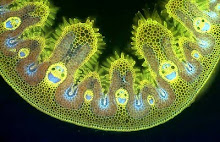If we had enough space in our back garden I would plant one of the large flowered, tree-sized Magnolia species or hybrids - probably M. x soulangeana - but we only have room for the Star Magnolia, M. stellata which comes from Japan and produces many fine flowers on a relatively compact plant. It's the earliest-flowering magnolia and the weather here over the last week, which has been unremittingly warm and sunny, has been kind to the 15 year-old specimen in garden. In a couple more days it will be at its best, but four days from now temperatures are forecast to plummet, with maybe even some snow, so the current pristine display of flowers will probably suffer from some frost damage by the middle of next week and those pure white tepals will be scarred with brown patches.
Part of the pleasure from growing this plant comes from watching the attractive furry flower buds swell, bringing a growing sense of expectation. When the bud scales part and the pink tepals begin to force their way out, you know that spring is gathering pace.......... but anticipation is tempered by the knowledge that spring can be fickle. It looks like this year's display of starry flowers will be short-lived...... but spectacular while it lasts.

































